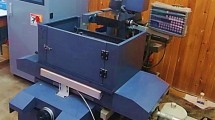Abstract
This paper investigates the technological capabilities of a hybrid micro machining process for performing wire electro-discharge grinding (WEDG). In particular, micro wire electrical discharge machining (μWEDM) is employed in combination with a rotating submergible spindle to perform WEDG. In this research, first a machining strategy for workpiece preparation is presented. Then, the effects of different machining setup parameters on the achievable surface finish after WEDG are investigated. In particular, an experimental study was conducted to identify the most statistically significant setup parameters for performing the main cut that affect the resulting surface quality. A signal-to-noise (S/N) ratio analysis was conducted to optimise the technological parameters for performing WEDG. By modifying the discharge energy for main cuts when performing WEDG surface finish comparable to that of μWEDM can be achieved. In addition, a simple and cost-effective method for on-the-machine estimation of resulting surface roughness is proposed. Especially, by applying inductive learning a surface roughness prediction model for WEDG can be generate based on data acquired by monitoring on-line the process.
Similar content being viewed by others
References
Ho KH, Newman ST, Rahimifard S, Allen RD (2004) State of the art in wire electrical discharge machining (WEDM). Int J Mach Tool Manuf 44(12–13):1247–1259
Kunieda M, Lauwers B, Rajurkar KP, Schumacher BM (2005) Advancing EDM through fundamental insight into the process. CIRP Ann Manuf Technol 54(2):599–622
Masuzawa T, Fujino M, Kobayashi K (1985) Wire electro-discharge grinding for micro-machining. Annals of the CIRP 34(1):431–434
Yu ZY, Masuzawa T, Fujino M (1998) Micro-EDM for three-dimensional cavities—development of uniform wear method. Annals of the CIRP 47/1:169–172
Masuzawa T, Yamaguchi M, Fujino M (2005) Surface finishing of micropins produced by WEDG. CIRP Ann Manuf Technol 54(1):171–174
Rajurkar KP, Levy G, Malshe A, Sundaram MM, McGeough J, Hu X, Resnick R, DeSilva A (2006) Micro and nano machining by electro-physical and chemical processes. CIRP Ann Manuf Technol 55(2):643–666
Piltz S, Uhlmann E (2006) Manufacturing of cylindrical parts by electrical discharge machining processes. Proceedings of the 1st International Conference on Micromanufacturing ICOMM, p 227–233
Rees A, Dimov S, Ivanov A, Herrero A, Uriarte L (2007) Micro-electrode discharge machining: factors affecting the quality of electrodes produced on the machine through the process of wire electro-discharge machining. Proc IME B J Eng Manufact 221:409–418
Qu J, Shih AJ, Scattergood RO (2002) Development of the cylindrical wire electrical discharge machining process. Part 1. Concept, design, and material removal rate. Journal of Manufacturing Science and Engineering, Transactions of the ASME 124(3):702–707
Qu J, Shih AJ, Scattergood RO (2002) Development of the cylindrical wire electrical discharge machining process. Part 2. Surface integrity and roundness. Journal of Manufacturing Science and Engineering, Transactions of the ASME 124(3):708–714
Juhr H, Schulze HP, Wollenberg G, Künanz K (2004) Improved cemented carbide properties after wire-EDM by pulse shaping. J Mater Process Technol 149(1–3):178–183
Mohammadi A, Tehrani AF, Emanian E, Karimi D (2008) Statistical analysis of wire electrical discharge turning on material removal rate. J Mater Process Technol 205(1–3):283–289
Haddad MJ, Fadaei Tehrani A (2008) Material removal rate (MRR) study in the cylindrical wire electrical discharge turning (CWEDT) process. J Mater Process Technol 199(1–3):369–378
Matoorian P, Sulaiman S, Ahmad M (2008) An experimental study for optimization of electrical discharge turning (EDT) process. J Mater Process Technol 204(1–3):350–356
Roy R (1990) A primer on the Taguchi method. Van Nostrand Reinhold, New York
Montgomery DC (2000) Design and analysis of experiments. Wiley, New York
Mason RL, Gunt RF, Hess JL (2003) Statistical design and analysis of experiments. Wiley, New York
Phadke MS (1989) Quality engineering using robust design. Prentice Hall, Englewood Cliffs, NJ
Ross PJ (1988) Taguchi techniques for quality engineering. McGraw Hill, New York
Tsai KM, Wang PJ (2001) Predictions on surface finish in electrical discharge machining based upon neural network models. Int J Mach Tool Manuf 41(10):1385–1403
Pham DT, Dimov SS (1997) Efficient algorithm for automatic knowledge acquisition. Pattern Recognition 30(7):1137–1143
Author information
Authors and Affiliations
Corresponding author
Rights and permissions
About this article
Cite this article
Rees, A., Brousseau, E., Dimov, S.S. et al. Development of surface roughness optimisation and prediction for the process of wire electro-discharge grinding. Int J Adv Manuf Technol 64, 1395–1410 (2013). https://doi.org/10.1007/s00170-012-4110-7
Received:
Accepted:
Published:
Issue Date:
DOI: https://doi.org/10.1007/s00170-012-4110-7




